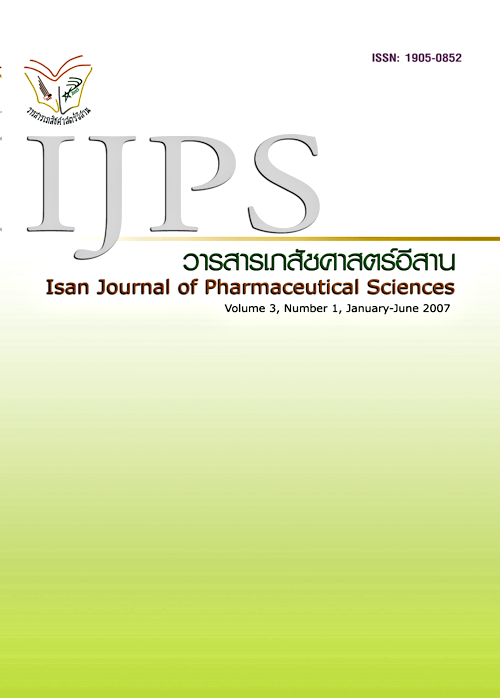Cost-Effectiveness Analysis of Type 2 Diabetes Disease Management in District Hospital Context: An Analysis Using CORE Diabetes Model
Main Article Content
Abstract
Type 2 diabetes is a chronic disease which is a major health problem. Currently, the American Diabetes Association published clinical practice recommendations for diabetes care, prevention and management of complications and treatment goal. However, diabetes care in Thailand has not been complied with the guideline particularly in district hospitals due to limited resource. More than 50% of diabetic patients do not achieve target goal. The aims of this study were to calculate the projected long term clinical outcomes and cost-effectiveness analysis of diabetes disease management compared with diabetes usual care. CORE Diabetes Model was used to calculate life expectancy, quality-adjusted life expectancy (QALY), incidence of diabetes complications, lifetime cost and incremental cost-effectiveness ratio (ICER) using time frame of 35 years and health care provider perspective. Over a 35 year period, life expectancy were 9.52 and 8.39 years which were equivalent to 6.59 and 5.73 QALYs for disease management and usual care, respectively. An ICER of disease management as compared with usual care was 12,607 Baht per QALY. Moreover, disease management can decrease incidence of complications and improve time alive and free of complication. Sensitivity analysis showed that improvement in hemoglobin A1c, systolic blood pressure and coverage of renal replacement therapy led to improve cost-effectiveness. In conclusion, type 2 diabetes disease management is considered the cost-effectiveness management in district hospital context.
Article Details
In the case that some parts are used by others The author must Confirm that obtaining permission to use some of the original authors. And must attach evidence That the permission has been included
References
Aekplakorn W, Stolk RP, Neal B, et al., INTERASIA Collaborative Group. 2003. The prevalence and management ofdiabetes in Thai adults: the interna-tional collaborative study of cardiovas-cular disease in Asia. Diabetes Care26(10): 2758-63.
American Diabetes Association (ADA). 2006. Standard of medical care in diabetes 2006: position statement. Diabetes Care 29(1): S1-42
Chetthakul T, Pongchaiyakul C, TandhanandS. 2006. Improvement of diabetic careat Maharat Nakhon RatchasimaHospital (the study of Diabcare-Asiafrom 1997 to 2003). J Med Assoc Thai 89 (1):56-62.
Chirakup S. 2006. Cost-effective analysis ofthiazolidinediones in uncontrolled type 2diabetes in uncontrolled type 2 diabeticpatients receiving sulfonylureas andmetformin in Thailand. Master thesis inpharmaceutical sciences Graduate schoolof Naresuan University.
Disease Management Association of America.n.d. Definition of disease management. http://www.dmaa.org/definition.html. Accessed May 12, 2006.
Gerstein HC, Yusuf S, Mann J, et al. 2000.Effect of ramipril on cardiovascularand microvascular and microvascularoutcomes in people with diabetesmellitus: results of the HOPE studyand MICRO-HOPE substudy. Lancet355; 253-59
Nitiapinyasakul A and Nitiapinyasakul N. 1999. Risk factors of ophthalmic complicationsin diabetes. Thai J Ophthalmol 13 (1):23-32.
Palmer AJ, Roze S, Valentine WJ, et al., 2004. The CORE Diabetes Model: Projecting long-term clinical outcomes,costs and cost-effectiveness ofinterventions in diabetes mellitus (types 1 and 2) to support clinical andreimbursement decision-making. Curr Med Res Opin 20(Suppl 1):S5-26.
Sriratanasathavorn C, Bhuripanyo K, MahanondaN, Leowattana W, Ruangratanaamporn O,Chotinaiwattarakul C, et al. 2000. Theprevalence of left ventricular hypertrophyand associated factors in a Thaipopulation. J Med Assoc Thai 83(Suppl 2): S218-22.
UK Prospective Diabetes Study Group. 1998. Intensive blood-glucose control withsulphonylureas or insulin compared withconventional treatment and risk ofcomplications in patients with type2 diabetes (UKPDS 33). Lancet352 (9131): 837- 53.
Wild S, Roglic G, Green A, et al., 2000.Global prevalence of diabetes:estimates for the year 2000 andprojections for 2030. Diabetes Care27(5):1047-53.
World Bank. The 1993 world developmentreport, investing in health. OxfordUniversity press, Wachington DC.pp125-176.
Teerawattananon Y, Mugford M, Tangcharoen-sathien V. 2007. Economic evaluationof palliative management versus peritonealdialysis and hemodialysis for end-stagerenal disease: evidence for coveragedecisions in Thailand. Value Health10(1): 61-72.


